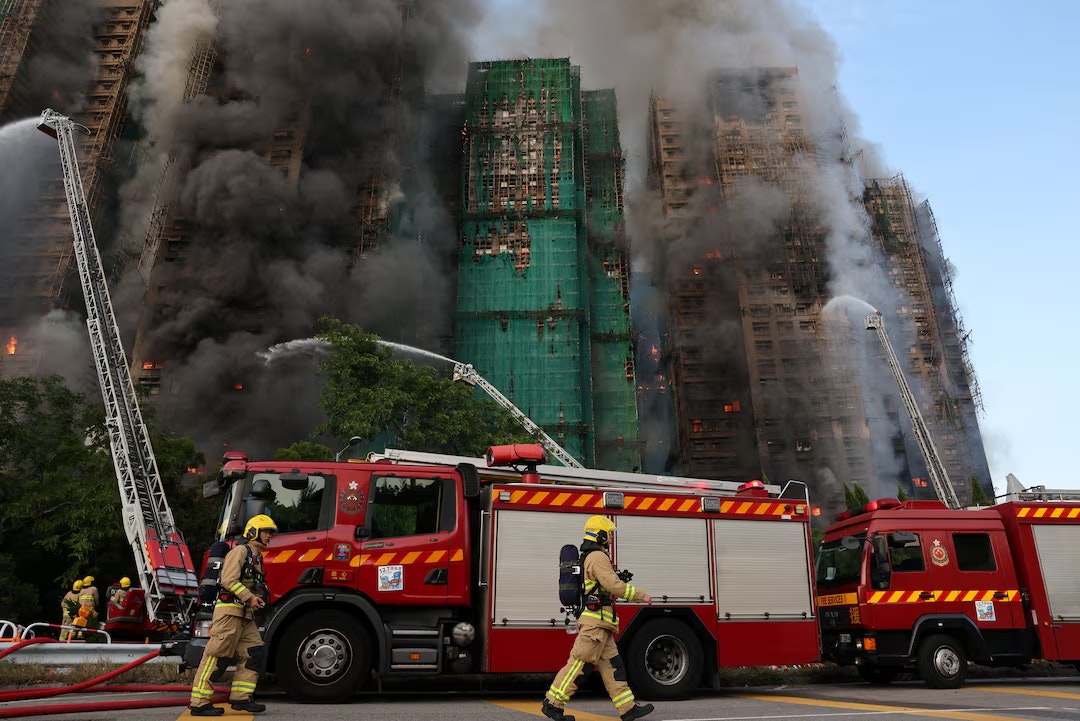Wang Fuk Court

Posted November 27, 2025
On November 26, 2025, a devastating fire swept through Wang Fuk Court, a large residential complex in Hong Kong’s Tai Po District. Several high-rise blocks were wrapped in scaffolding and renovation netting, conditions that allowed the fire to spread with extraordinary speed. The incident became one of the deadliest residential fires in Hong Kong in decades and was ultimately classified as a “No. 5 alarm,” the highest level of emergency.
Size and Scope
The fire began at approximately 2:51 p.m. and grew with alarming speed. Wang Fuk Court consists of eight 30-story towers; reports indicate that as many as seven of those buildings were involved at one point. Because the complex was under renovation, the scaffolding and protective mesh around the structures acted as fuel, igniting and carrying flames vertically from floor to floor.
Casualties
Authorities have reported at least 65 fatalities, including one firefighter, and more than 77 injured residents. Hundreds remain unaccounted for as search operations continue. More than 900 displaced residents have been relocated to temporary shelters, marking one of the largest mass-displacement events in Hong Kong in recent years.
Cause and Investigation
Preliminary findings suggest the blaze began externally on scaffolding or construction netting. Investigators believe flammable renovation materials — including mesh and plastic sheeting — intensified the spread. Police have arrested three individuals connected to the renovation work on suspicion of manslaughter, citing gross negligence. A full inquiry is underway, with mounting evidence pointing toward failures in building-safety oversight and renovation practices.

Response of Firefighters and Emergency Personnel
Alarm and Arrival
The Hong Kong Fire Services Department (FSD) received the first alarm moments after ignition. Firefighters arrived within five minutes to find the exterior scaffolding already engulfed. Recognizing the severity, officers immediately initiated rescue operations, escalating the alarm level multiple times before declaring a No. 5 alarm by early evening.
Massive Mobilization
At the height of operations, over 1,200 fire and ambulance personnel were deployed, supported by more than 200 fire apparatus and 100 ambulances. Crews used turntable ladders, high-level water streams, and external attack lines to battle flames racing up the scaffolded exteriors. Twenty-six search-and-rescue teams worked simultaneously across multiple towers, while more than 400 police officers assisted with evacuation and perimeter control.
Operational Challenges
Conditions were among the most hazardous a high-rise incident can present. Scaffolding collapsed as it burned. Heavy smoke, extreme heat, and falling debris made upper floors nearly inaccessible for long stretches. Internal rescues were attempted wherever safe access existed, but in many areas the fire’s speed outpaced the time available to reach trapped residents. Despite these dangers, rescue teams continued internal searches on lower floors while exterior crews fought to slow the fire’s advance.
Tribute to First Responders
Residents and witnesses consistently noted how quickly the first units arrived and how many resources were ultimately committed. Emergency shelters were opened promptly, and support services mobilized to care for the displaced. Many survivors expressed deep gratitude for the determination and courage of those who responded under extraordinarily dangerous conditions.
At the same time, public discussion in Hong Kong has focused on broader issues: the flammability of renovation materials, the vulnerability of high-rise estates undergoing construction, and questions about oversight and safety enforcement. These concerns are directed largely at systemic factors rather than at the first responders who worked under near-impossible conditions.
Lessons for the Fire Service
The tragedy at Wang Fuk Court underscores how quickly a renovation site can become a large-scale fire hazard — especially in densely populated, vertical communities. It also highlights the importance of strong building-safety standards, material oversight, and ongoing public-education efforts about fire safety during construction.
For the fire service, the incident is a solemn reminder that even a massive, rapid, and well-coordinated response may face limits imposed by building conditions and the speed of fire spread. Yet the courage and professionalism of the responding crews stand out. Their actions reflect the highest traditions of the fire service worldwide.
